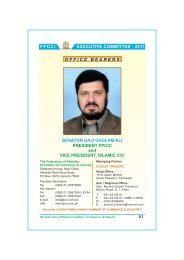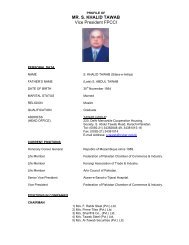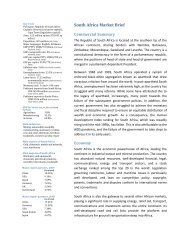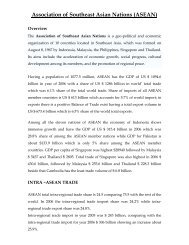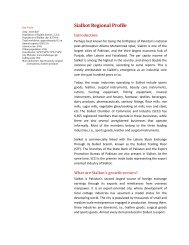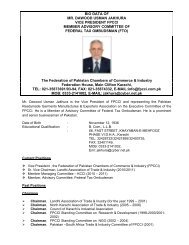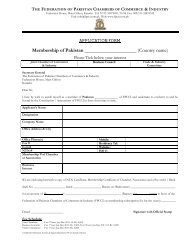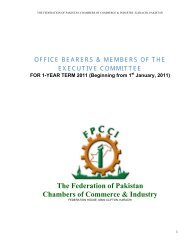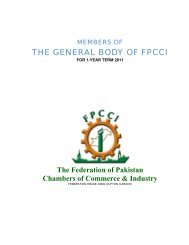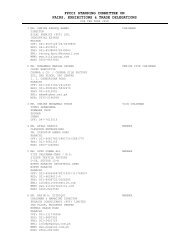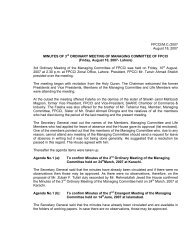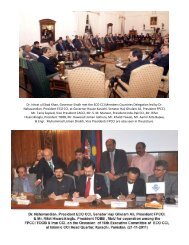Summary of Factors Hindering Pakistan's Trade with India
Summary of Factors Hindering Pakistan's Trade with India
Summary of Factors Hindering Pakistan's Trade with India
You also want an ePaper? Increase the reach of your titles
YUMPU automatically turns print PDFs into web optimized ePapers that Google loves.
FPCCI – Research & Development<strong>Factors</strong> <strong>Hindering</strong> Pakistan’s <strong>Trade</strong> <strong>with</strong> <strong>India</strong>April 20, 2011A. Problems faced by Pakistani ExportersI. Land <strong>Trade</strong> Facilitation1. Rail Routea. There are several bottlenecks on the rail route, such as the unavailability <strong>of</strong>necessary equipment such as rail wagons, rakes, etc, and insufficientinfrastructure, such as customs house agents, sheds, and weighing and X-raymachines.b. No cargo trains are allowed through the Sindh route, even though aconsiderable amount was spent on widening the gauge <strong>of</strong> tracks. Openingthis route will save a huge amount <strong>of</strong> freight now being paid as ocean freightto shipping lines, which take almost ten days for loading and unloading. Onthe other hand, trains would allow cargo to reach dry ports <strong>with</strong>in a period <strong>of</strong>24 hours at lower handling cost.2. Road Routea. Only a limited number <strong>of</strong> items are allowed to be traded via the road route.There is no warehousing facility on either side <strong>of</strong> the border. There is no coldstorage facility available at the border, even though perishables are <strong>of</strong>tentraded. <strong>Trade</strong> takes place only from 8:00 a.m. to 4:00 p.m., after which thegate is shut. There is no warehouse-to-warehouse transportation facility.b. A cross-truck Transportation Agreement was signed in August/September2007, allowing 100 trucks daily from each side <strong>of</strong> the Wagah/Attari checkpost. Approximately 100 <strong>India</strong>n trucks enter Pakistan daily <strong>with</strong> <strong>India</strong>nproducts since 2007. But regretfully, the <strong>India</strong>n side does not allow Pakistanitrucks to cross into <strong>India</strong> to date.Suggestions:1. Trading <strong>of</strong> all items through land routes (Sindh and Punjab) should be taken up moreseriously, and the process should be smoothened.2. As there is insufficient space on trains, it is necessary to allow recognized andregistered transport companies’ trucks to transfer goods from warehouse-towarehouse.This will save us extra handling charges on logistics and goods can bedelivered to dry ports, or customs bonded houses.2
FPCCI – Research & DevelopmentApril 20, 2011II.Technical barriers to trade1. <strong>India</strong>n certification requirements, especially by the Bureau <strong>of</strong> <strong>India</strong>n Standards(BIS), have affected the export <strong>of</strong> our products, such as textiles, fresh fruits,vegetables and cement, to <strong>India</strong>. Many commodities cannot enter <strong>with</strong>out qualitycertification by the BIS.2. There are 24 <strong>India</strong>n standard setting bodies, both at the centre and state level,unlike Pakistan, where there is a single authority. Foreign exporters are <strong>of</strong>tenconfused about what the national standard is.3. There is also a multiplicity <strong>of</strong> rules and regulations, multiple certifying bodies, andseveral agencies involved in enforcement <strong>of</strong> standards. This creates confusionamong exporters about who the certifying agencies are, and what law/regulationshould be applicable from amongst the multiple laws for the same purpose.4. <strong>India</strong> has enforced mandatory certification for 109 products, down from over 150products some time back. The mandatory quality certification covers a wide range<strong>of</strong> products: e.g. food items, food colours, cement, gas cylinders and valves,electrical appliances and accessories, multipurpose dry batteries, X-ray equipment,feeding bottles, mineral water and clinical thermometers etc. Imports <strong>of</strong> theseitems are allowed only after Bureau <strong>of</strong> <strong>India</strong>n Standards certification andpermission to use the BIS mark.5. For certification <strong>of</strong> these 109 items, detailed requirements have been issued under 7different acts. It is a general complaint that there is no single <strong>of</strong>ficial publicationthat covers all information on tariffs, fees and tax rates as well as the legislationsunder which certain formalities are to be completed. All these are given in differentacts and all acts have detailed rules. Most <strong>of</strong> the requirements emanate from theserules. This makes the whole system very cumbersome, time consuming andopaque. Hence, there is total lack <strong>of</strong> transparency. The standards specified are inmany cases stricter than even the international standards e.g. standards for bottledwater are stricter than the internationally accepted Codex Alimentarius and thoseadopted by EU.6. According to <strong>India</strong>n legislation, applicants for BIS licences have to pay applicationfees, processing charges, and expenses <strong>of</strong> the inspection visits from <strong>India</strong> toPakistan or wherever the applicant’s manufacturing facilities are located. Testingcosts, annual marking fees for the licences and licence fees have to be paidseparately. The foreign manufacturer is also required to set up a liaison or branch<strong>of</strong>fice located in <strong>India</strong> <strong>with</strong> the permission <strong>of</strong> Reserve Bank <strong>of</strong> <strong>India</strong>. The branch<strong>of</strong>fice itself is also required to meet all requirements <strong>with</strong> respect to BIS acts, rulesand regulations for the purposes <strong>of</strong> BIS license and the rules/regulations <strong>of</strong> theReserve Bank <strong>of</strong> <strong>India</strong>.7. A license issued for any product is valid for one year only and has to be renewedannually. Before the renewal, new inspections and testing <strong>of</strong> samples are required.3
FPCCI – Research & DevelopmentApril 20, 2011All the costs, as well as renewal fees must again be borne by the applicant firms,year after year. Licensing fees include the cost <strong>of</strong> the initial inspector’s visit andtests, an annual fee <strong>of</strong> approximately $2,000. The marking fee is 1% <strong>of</strong> the value <strong>of</strong>certified goods imported into <strong>India</strong>. This is virtually a 1% Customs Duty collectedon the entire imports.8. A system now exists by which foreign companies can receive direct certification forproducts made outside <strong>India</strong>, provided BIS has first inspected the productionfacility (at the manufacturer’s expense). This system is however not <strong>with</strong>outproblems and all the above requirements have to be fulfilled.9. In the case <strong>of</strong> labelling and marking requirements the importers also face difficulties<strong>with</strong> the controls carried out by accredited laboratories. The results <strong>of</strong> thelaboratory tests cannot be challenged. There is no maximum time limit for the tests.Sometimes, the accredited laboratory wrongly classifies and analyses the productunder different standards, thus creating uncertainty and confusion. In many <strong>of</strong> thecases, the importer is burdened <strong>with</strong> heavy storage charges and the products arenot always stored in adequate conditions.10. Specific Technical Barriersa. Textilesi. Pakistan is in a position to market its textiles in <strong>India</strong> but the strict conditionslaid down under the Textiles (Consumer Protection) Regulation <strong>of</strong> 1988,are a major barrier.ii. Pakistani fabric exporters are required to obtain a pre-shipment certificatefrom a textile testing laboratory in Pakistan certifying non-use <strong>of</strong>hazardous dyes. In some cases even the EU accredited labs have beenrejected by <strong>India</strong>n customs making zero rate exports impossible.b. Cementi. Cement imports into <strong>India</strong> are subject to registration by the BIS. Beforegetting BIS certificates, many formalities have to be met, includingphysical inspection <strong>of</strong> the manufacturing units by a BIS team andexamination <strong>of</strong> samples drawn for laboratory tests.ii. Cement exports to <strong>India</strong> from Pakistan have decreased from 60,000 tonesmonthly average to a mere 15,000 tones mainly due to the delay inrenewal <strong>of</strong> quality certification by BIS. Our exporters’ BIS certificates hadexpired in August 2010. Exporters are waiting for BIS certificates for last5-6 months (they had applied in June 2010)4
FPCCI – Research & DevelopmentApril 20, 2011c. Food itemsi. The rules and regulations regarding food items are very complicated anddetailed, and provide enormous powers to the customs authorities, todetain and even completely stop imports, for minor infringements <strong>of</strong>rules and procedures.ii. Rule 32 <strong>of</strong> the Prevention <strong>of</strong> Adulteration <strong>of</strong> Food Rules, 1955 framed underthe powers derived from the Act <strong>of</strong> the same name, is a classic example.Rule 32 deals <strong>with</strong> the packing and labeling <strong>of</strong> foods. This rule alone has30 provisos and provisos <strong>with</strong>in provisos. In addition, there are also crossreferences to other rules. These rules prescribe the contents to bespecified on the label, the size <strong>of</strong> the label, the design <strong>of</strong> the label, theareas specified for display panels, details <strong>of</strong> colours and flavours, tradename or description <strong>of</strong> food contained in the package, names <strong>of</strong>ingredients used in the product by weight and volume etc.iii. In the case <strong>of</strong> artificial flavouring substances the label may not declare thechemical names <strong>of</strong> the flavour. In the case <strong>of</strong> natural flavouringsubstances or natural identical flavouring substances, the common name<strong>of</strong> flavours has to be used.iv. If gelatin is used as an ingredient the word “gelatin – animal origin” is to beinscribed. If any article <strong>of</strong> food contains whole or part <strong>of</strong> any animalincluding birds, fresh water or marine animals or eggs or products <strong>of</strong> anyanimal origin (but not including milk or milk products) a declaration is tobe made by symbols and colour code to indicate that the product is nonvegetarian food.v. A declaration is also to be given wherever any article <strong>of</strong> food contains eggs asthe only non-vegetarian ingredient. In the case <strong>of</strong> any bottle containingliquid milk or s<strong>of</strong>t drink having milk, carbonated water etc., fulldeclaration about fruit pulp and fruit juice and other contents has to beprovided. A separate but similar declaration is also to be made in respect<strong>of</strong> returnable bottles which are recycled for refilling.vi. Packages <strong>of</strong> confectionary weighing 20 grams or less are however exemptfrom the declaration <strong>of</strong> the ingredients and from the declaration <strong>of</strong> animalorigin.vii. A 100% check is normally done on food products before customs clearance.The laboratories are meant to conduct the control <strong>of</strong> compliance, <strong>with</strong> thePrevention <strong>of</strong> Food Adulteration Rules, Standards and Measures Rulesand other requirements (such as control <strong>of</strong> the mark <strong>of</strong> certification forthe products subject to compulsory certification or the requirements onnon vegetarian symbols or vegetarian symbols and any requirementunder other acts such as Meat Food Product Order, 1973, Plants, Fruits5
FPCCI – Research & DevelopmentApril 20, 2011and Seeds Order, 1989; the Livestock Act etc). This means that theproduct composition, the size <strong>of</strong> packaging as well as the labels arethoroughly checked.Suggestions:The cumulative effect <strong>of</strong> all these requirements is so discouraging, that exporters shy awayfrom the <strong>India</strong>n market, despite its enormous potential. The existing system appears to bedesigned solely to discourage exports to <strong>India</strong>, and protect the local industry in the garb <strong>of</strong>standards to protect the consumers or users. This is surely the responsibility <strong>of</strong> everyGovernment, but in this case, the responsibility has been turned into a TBT (TechnicalBarrier to <strong>Trade</strong>) as well as a Tariff Barrier. Therefore, BIS certification should bestreamlined in order to protect both countries’ interests.III.Problems in Conducting the <strong>Trade</strong> <strong>of</strong> Cotton1. In the year 2000, the Government <strong>of</strong> <strong>India</strong> imposed a ban on import <strong>of</strong> raw cottonfrom Pakistan on the grounds that it contains exotic strains <strong>of</strong> destructive bacterial,viral and fungal disease which is virulent under <strong>India</strong>n climate conditions.2. The Government <strong>of</strong> <strong>India</strong> has imposed a duty on cotton export to discourage theexport <strong>of</strong> cotton from <strong>India</strong>, and has <strong>with</strong>drawn some incentives for exporters <strong>of</strong><strong>India</strong>n cotton hoping to curb the soaring price <strong>of</strong> cotton.3. In April, 2010, the <strong>India</strong>n Government placed a ban on the export <strong>of</strong> raw <strong>India</strong>ncotton to Pakistan and suspended all export sales contracts that were alreadyregistered. However, due to the pressure <strong>of</strong> <strong>India</strong>n farmers and exporters, the<strong>India</strong>n government decided at a later stage to allow the export <strong>of</strong> cotton until theallocated quota <strong>of</strong> 5.5 million bales (<strong>of</strong> 170 kg) for shipment gets exhausted. Due tothe unfair move <strong>of</strong> <strong>India</strong>n Government, the buyers <strong>of</strong> <strong>India</strong>n cotton/textile millsfaced a lot <strong>of</strong> difficulties in meeting their urgent requirement <strong>of</strong> raw cotton andfulfilling their contractual obligations in the international market.IV.Problems in Conducting the <strong>Trade</strong> <strong>of</strong> Automobiles1. A new imported vehicle is defined in <strong>India</strong> as a vehicle that has not beenmanufactured or assembled in <strong>India</strong>; neither been sold, leased or loaned prior toimportation into <strong>India</strong>, nor been registered for use in any country, prior to importinto <strong>India</strong>. New vehicles can only be imported from the country <strong>of</strong> manufacture andtheir import is permissible only through three Customs ports at Nhava Sheva,Calcutta and Chennai. None <strong>of</strong> the Land Customs ports issued licenses for the same.Such special licences are only delivered to local joint venture automotivemanufacturers who have signed a Memorandum <strong>of</strong> Understanding (MoU) <strong>with</strong> theDirectorate General <strong>of</strong> Foreign <strong>Trade</strong>.6
FPCCI – Research & DevelopmentApril 20, 20112. The certification <strong>of</strong> road safety tests, emission standards tests and the“Homologation Certificate”, generally require at least six months, <strong>of</strong> very strenuousand detailed tests. At the end <strong>of</strong> all these tests however, nobody is 100% sure <strong>of</strong>getting certified.V. Problems in Conducting the <strong>Trade</strong> <strong>of</strong> Marble1. Import <strong>of</strong> “Marble and Travertine – Crude or roughly trimmed, merely cut, bysawing or otherwise, into blocks or slabs <strong>of</strong> a rectangular (including square) shape& other calcareous stone” is restricted and subject to import licensing procedures.Applications for such licences are considered by a facilitation committee (an interministerialcommittee comprising <strong>of</strong> representatives from variousministries/departments).2. The facilitation committee considers applications for import for the subjectproducts in the following manner:a. Eligibility: Entitlement would be restricted to those applicants who have setup manufacturing/processing units in the country and have made imports <strong>of</strong>these items in the preceding years.b. Floor Price: Grant <strong>of</strong> licences is subject to floor prices which are endorsedon all licences.VI.Problems in Conducting the <strong>Trade</strong> <strong>of</strong> Woolen Textiles1. Import <strong>of</strong> all woollen textiles and woollen blended textiles are governed by thenotification dated 7 th March, 1988 read <strong>with</strong> The Textile (Development andRegulation) Order, 2001 and The Essential Commodities Act, 1955.2. Imports are subject to the conditions that all imports <strong>of</strong> woollen textiles andwoollen blended fabrics are required to display markings indicating thecomposition <strong>of</strong> fibre blends. All consignments are also required to be accompaniedby a pre-shipment inspection certificates from a textile testing laboratory <strong>of</strong> thecountry <strong>of</strong> origin certifying the composition <strong>of</strong> the woollen textile and blends.3. Consignments not accompanied by a pre-shipment inspection certificate are notallowed to be cleared till the samples <strong>of</strong> the imported consignment are tested andcertified from any one <strong>of</strong> the agencies mentioned in Public Notice No.12 dated 3 rdMay, 2001. This can take anywhere from one week to three months, <strong>with</strong> all theconsequential costs.4. A certificate <strong>of</strong> origin is also required for all woollen textile products, even if noconcessions are being claimed. In addition, a certificate from brand ownerscertifying that the product is genuine and the exporters and/or manufacturers havethe authority to use the brand name, must accompany the consignment. This is7
FPCCI – Research & DevelopmentApril 20, 2011required for each and every consignment separately, ostensibly to protect thebrand name and the consumers from spurious products. One all embracingcertificate is however not accepted by the customs authorities and this process hasto be repeated each time an import is affected, for every consignment.VII. Para-tariff measures1. <strong>India</strong> imposes a countervailing duty <strong>of</strong> 16.3% on most items, a specialcountervailing duty <strong>of</strong> 4% and an education cess <strong>of</strong> 2%.2. Exporters in Pakistan have to mention the minimum retail price (MRP) on packagedfoods, but they are unable to so because they do not always have information ondistribution costs that would be incurred in <strong>India</strong>.3. <strong>Trade</strong>rs in Pakistan find the costs <strong>of</strong> their exports prohibitive on account <strong>of</strong> interstatetaxes imposed on movement <strong>of</strong> goods in <strong>India</strong>.VIII. Visa difficulties1. Due to the lengthy procedure <strong>of</strong> issuance <strong>of</strong> business visas for <strong>India</strong>, Pakistanitraders are facing great problems in obtaining business visas and proceeding to<strong>India</strong> in a timely fashion to meet their counterparts to finalize their business deals.2. Consulates in both countries exercise tremendous discretionary powers in grantingvisas and waiving visa requirements that include exemption from scrutiny by theMinistry <strong>of</strong> Home Affairs in <strong>India</strong>/Ministry <strong>of</strong> Interior in Pakistan, extending thelength <strong>of</strong> stay, exemption from police reporting and number <strong>of</strong> cities to be visited.Selected traders who are beneficiaries <strong>of</strong> such largesse make repeated visits andhave access to trade related information.3. Lack <strong>of</strong> transparency, market imperfections and information asymmetries <strong>of</strong> thiskind raise transaction costs and restrict market access for several other aspiringtraders.Suggestions:The easing <strong>of</strong> business visa restrictions, <strong>with</strong> removal <strong>of</strong> the exempted police report (EPR)requirement, is one the main issues which must be addressed. Businessmen recommendedby FPCCI and FICCI should be allowed travel <strong>with</strong>out limited restrictions and number <strong>of</strong>cities.IX.Inconsistent policiesInconsistent policies <strong>of</strong> the <strong>India</strong>n government especially <strong>with</strong> regards to cotton andYarn exports from <strong>India</strong> whereby all <strong>of</strong> sudden a registration/restriction is imposedprovide the <strong>India</strong>n suppliers a legitimate excuse to back out <strong>of</strong> their contractualobligations.8
FPCCI – Research & DevelopmentApril 20, 2011Suggestions:Any change <strong>of</strong> policy should protect existing contracts and be applicable to new contractsX. Unhelpful Customs Procedures1. Customs procedures are unhelpful for Pakistani traders. Excessive checks are <strong>of</strong>tencarried out for consignments imported from Pakistan on security grounds. As aresult, goods may be held up for several days before they are cleared.2. Electronic goods declarations filing (EDI) is not available at the land-border tradingpoints in both countries, even though it has been introduced otherwise.3. Commodities not on the negative list can benefit from SAFTA concessions, providedtraders submit a “rules <strong>of</strong> origin” certificate. Due to lack <strong>of</strong> integration between thecustoms and the issuing authorities, this is separate from customs documentation,and adds to transactions cost.4. The Customs Department also makes general but detailed checks as under:a. The condition <strong>of</strong> the hold in which the products were transported, in order tosee whether or not it meets the requirements <strong>of</strong> storage and does not causedeterioration or contamination <strong>of</strong> the products.b. The physical/visual appearance <strong>of</strong> goods in terms <strong>of</strong> possible damage is alsochecked (whether the product is swollen or bulged in appearance orcontaminated by rodents or insects, presence <strong>of</strong> filth, dirt, etc.)c. The products meet the detailed labeling requirements under the Prevention<strong>of</strong> Food Adulteration Rules, 1955 and the Packaged Commodities Rules,1995.5. All consignments <strong>of</strong> imported food products have to be referred to the Port HealthOfficer (PHO) for testing. At the customs clearance points where PHOs are notavailable, the Customs are required to draw the samples and get them tested fromthe nearest Central Food Laboratory or a Laboratory authorised by the DirectorateGeneral <strong>of</strong> Health Services. Clearance is allowed only after receipt <strong>of</strong> the test report.If the products fail the test, the goods have to be re-exported out <strong>of</strong> the country ordestroyed. Delays in such testing are endemic.6. Both <strong>India</strong>n importers, and EU and other country exporters <strong>of</strong> food products havecomplained that they face growing difficulties <strong>with</strong> customs clearance <strong>of</strong> foodproducts. Earlier, <strong>India</strong>n authorities used to release packed food products, on thebasis <strong>of</strong> health certificates issued by the countries <strong>of</strong> origin. This has now beenstopped completely. The long period <strong>of</strong> time taken to issue the test certificates, aswell as the limited number <strong>of</strong> designated labs available are major sources <strong>of</strong>distress for the exporters <strong>of</strong> food items. The goods have to be detained for a longtime in the customs warehouses leading to heavy damages, as well as port anddemurrage charges.9
FPCCI – Research & DevelopmentApril 20, 20117. Moreover, the temperatures in the customs warehouses are not conducive to thepreservation <strong>of</strong> perishable goods. The lengthy procedures and tests are <strong>of</strong>ten selfdefeating,as food items which are by nature perishable, can deteriorate during thiswait in customs warehouses, where temperatures are not controlled. However,these are very effective as an NTB.XI.Subsidies<strong>India</strong> provides significant subsidies to producers and consumers, mainly inagriculture. Pakistan provides few subsidies, except in urea fertilizer production andelectricity supply to households. However, Pakistani wheat and cotton aresubsidized through support prices.XII.Financial Barriers1. Some <strong>India</strong>n banks do not recognize Letters <strong>of</strong> Credit (L/Cs) from all Pakistanibanks, and confirmation <strong>of</strong> L/Cs can take up to a month.2. Sometimes, there is a default in payment. There is no formal mechanism for thesettlement <strong>of</strong> trade disputes.3. Payments related to bilateral trade are made through the Asian Clearing Union(ACU). However, traders in both countries have complained about the inefficiency<strong>of</strong> the ACU system, particularly in terms <strong>of</strong> the time taken to settle transactions.4. Currently, <strong>India</strong>n banks are not allowed to have branches in Pakistan, whilePakistani banks are not allowed to operate in <strong>India</strong> as well.XIII. Miscellaneous barriers/issues1. Due to the strong <strong>India</strong>n Rupee vis-à-vis US Dollar, many chemicals i.e., soda ash etc.from Pakistan are competitive, resulting in their export to <strong>India</strong>. <strong>India</strong>n authoritiesare using tactics like fixing higher Import trade price (ITP) to evaluate customsimport duty, making the landed cost expansive to discourage imports fromPakistan. This matter should also be addressed.2. Pakistan jute mills can be very competitive in exporting jute products to <strong>India</strong>,especially the <strong>India</strong>n Punjab, but <strong>India</strong>n Government tenders are restricted to localmanufacturers.3. Many industrial items need special containers for trade, such as chlorine gas,sulphuric acid and caustic soda. If easy and open access to empty cylinders can bearranged, this would greatly benefit our exports to <strong>India</strong>. Both governments allowpassage for gas cylinders for refilling and for free onward delivery to <strong>India</strong>. Thisopportunity should be availed.10
FPCCI – Research & DevelopmentApril 20, 20114. There is a problem <strong>of</strong> very lukewarm enthusiasm on the Pakistan side: we need toidentify evolve and promote specifically viable products exclusively for <strong>India</strong>through an in-depth study <strong>of</strong> the <strong>India</strong>n market.5. There appears to be a sense <strong>of</strong> somewhat cold apathy on the <strong>India</strong>n side; we need tostimulate <strong>India</strong>n markets through our repeated visits and perhaps keep it onesidedfor some time. Include private trade initiatives, students, journalists,diplomats; business communities, women’s group and so on.6. Ineffective deliverance by TDAP and our trade Missions in <strong>India</strong>; if we at the <strong>India</strong>-Pakistan Chambers are really committed, we need to work <strong>with</strong> missionary zealand institute a task force assigned to make it happen.7. Ignorance <strong>of</strong> common interests; there can be a lot <strong>of</strong> products and services where<strong>India</strong> and Pakistan can pool resources for better global access and higher values,through cooperation instead <strong>of</strong> competition.8. There is a problem <strong>of</strong> disconnect <strong>with</strong> media which is working to improve Indo-Pakrelations; we need to establish a strategic networking <strong>with</strong> Amn ki Aasha toeffectively include the business agenda in this currently intellectual and socioculturalvoice.9. There is no trade in energy <strong>with</strong> Pakistan, while trade in services and IT is heavilyrestricted. The Iran-Pakistan-<strong>India</strong> gas pipeline project would reduce transport andcommunication costs.10. There are virtually no foreign direct investment (FDI) flows between the twocountries.XIV. Import duty1. Import duty on woven fabric containing 85% cotton or more by weight was 10% orRs.150, whichever was higher. The average unit export price <strong>of</strong> Pakistani fabric inOctober 2010 was $1.26 per square meter, equivalent to Pak Rs.108.36 and <strong>India</strong>nRs.57.10. 10% duty on Pakistani fabric would be only Rs.5.71 per square meter, butthe higher duty <strong>of</strong> Rs.150 was imposed, which means a duty <strong>of</strong> more than 2500%.2. The lowering <strong>of</strong> tariff rates is not <strong>of</strong> much consequence in the textiles sector becausethe revised tariff also lays down specific duties @ per meter or per kg <strong>with</strong> theproviso “whichever is higher” on major textile items. This obviously nullifies theimpression that ad-valorem duties on these products have come down from 30% to10% over the last five years.3. This in fact is no more than a smokescreen. These specific rates generally work outto more than 30% ad valorem even on high value products. On cheaper goods thead valorem percentage is obviously much higher. These specific rates seriouslydiscourage cheaper imports and directly protect domestic textile products.11
FPCCI – Research & DevelopmentApril 20, 2011Suggestions:1. Technically the duties levied were not discriminatory, but the duty structure definitelydiscourages low-cost fabric import. Pakistan should lobby to have the <strong>India</strong>n governmentremove import surcharge on polyester fabric, polyester/viscose (blended), home textilesand cotton shirting, which plastic items for industrial and home kitchen usage should begiven duty tariff concessions by Pakistan.2. Pakistan’s readymade garments like ladies’ suits (shalwar qameez), denim jeans andsportswear have a high demand in <strong>India</strong>. To encourage readymade garments properly,import duties on the same should be eradicated, in this way Pakistan can gain a substantialmarket share in <strong>India</strong>. If Pakistan is successful in convincing Government <strong>of</strong> <strong>India</strong> to reducethese duties, we can expect earning an additional US$ 1 billion for our nation.B. Problems faced by <strong>India</strong>n Exporters while trading <strong>with</strong> PakistanI. Inclusion <strong>of</strong> Sulphur and Polypropylene in the Land RouteThe biggest impediment to cross border land movement is the restrictive truckmovement and limited number <strong>of</strong> train bogeys. Furthermore, the carriage <strong>of</strong> bulkyitems such as sulphur and polypropylene by train is infeasible.1. Sulphur (HS Code 2503.0000)Sulphur is produced locally in Pakistan, but domestic production does not satisfy thedemand <strong>of</strong> 225,000 tons completely. In 2010, local refineries produced 55,000 tons<strong>of</strong> sulphur, whereas 168,000 tons were imported via sea. A large part <strong>of</strong> this demandcould be met by imports from <strong>India</strong>n refineries located near the Wagah border.2. Polypropylene (HS Code 3902.1000)Polypropylene is not produced locally, and 100% <strong>of</strong> the demand <strong>of</strong> 260,000 tons (in2010) is met through imports. Small quantities enter Pakistan from <strong>India</strong> via theland route, but due to the impediments <strong>of</strong> freight trains mentioned above, largeparcels cannot be imported.Suggestion:Considerable savings in freight could be achieved if imports <strong>of</strong> sulphur and polypropyleneare allowed via trucks. The shorter delivery periods would ensure lower inventory costsand hence even greater savings. Since sulphur is mainly used in the manufacture <strong>of</strong>phosphate fertilizers, therefore, the savings would ultimately benefit consumers in theshape <strong>of</strong> lower fertilizer prices. Similarly, addition <strong>of</strong> polypropylene to the trucking listwould increase importable quantities substantially and ensure greater savings for localindustry. Since polypropylene is mostly used in the manufacture <strong>of</strong> PP bags for packing12
FPCCI – Research & DevelopmentApril 20, 2011commodities such as cement, sugar, fertilizers, and household goods, consumers wouldshare in the benefit.II. Raw jute import restricted by road as per 3B (iii) <strong>of</strong> SRO 766(I) 2009dated 04-9-10Import <strong>of</strong> goods from <strong>India</strong> or <strong>India</strong>n origin is restricted to the items in Appendix-Gwhich doesn’t cover jute.Suggestion:Road transit <strong>of</strong> raw jute should be allowed in order to get timely and cheaper deliveryIII.Barriers in Exporting <strong>of</strong> Rice Bran OilRBO “Rice Bran Oil” (hydro Carbon Free) cannot be exported in bulk quantity asthere is a ban on its packaging above 5 litre packing <strong>of</strong> RBO in <strong>India</strong>.Suggestion:Its bulk quantity for jute processing should be allowed for import to Pakistan.IV.Export <strong>of</strong> Machinery or Parts to PakistanFollowing machinery and parts there<strong>of</strong> be included in the list <strong>of</strong> exportable items.1. Machinery not Exportable8445.2000- Spinning Frames8445.4020- Cone/Bobbin winding machines8445.4030- Reeling machine8446.1000-Weaving Machines for weaving fabrics <strong>of</strong> a width not exceeding 30 CM8446.2000-Weaving Machines for weaving fabrics <strong>of</strong> a width exceeding 30 CMshuttle Type.8446.2100-Power Looms2. Parts etc. not Exportable1516.2020-Vegetable Oils and their fractions (RBO)2710.1991-Mineral Oil (JBO)4010.0000-Belting for Machinery7319.0000-Steel Pins8448.3900-Other (Parts for carding/drawing/spinning /twisting and weavinglooms)13



